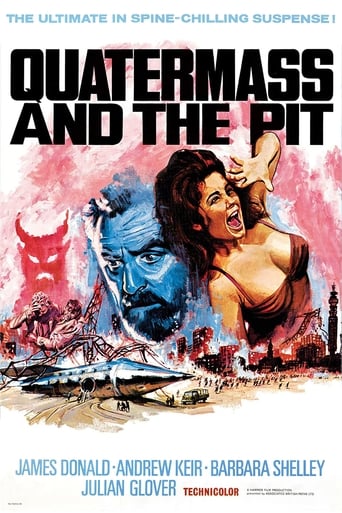classicsoncall
I never knew Hammer Studios did this type of science fiction until running across this picture as "Five Million Years to Earth". The title was changed for American audiences since "Quatermass and the Pit", didn't seem to have commercial appeal on this side of the pond. Besides the sci-fi quotient, there's a bit of a horror element in the story as well, with intimations of a devil at work in the Hob's End section of London where an underground tunnel has revealed an object of perhaps other worldly origins.Surprisingly, the story has a rather ambitious concept even if the execution seems rather hokey by today's standards. While the British government and military decide that the 'space ship' discovered during an underground dig is a holdover from the Nazi war machine, physics professor Bernard Quatermass (Andrew Keir) forms a theory that a centuries old, dormant faculty resides in the vehicle, and when awakened it displays eerie properties of telekinesis, second sight and poltergeist type movements. British scientist Barbara Judd (Barbara Shelley) experiences a 'stored memory' of the deceased creatures on board the ship, which are captured on film as depicting a Martian hive cleansing. It's the professor's considered opinion that centuries ago, Martians kidnapped ape-like creature from Earth to experiment on, in order to survive their own planet when it became inhospitable.Given all the tampering around and within the space vehicle, the Martian energy within it eventually comes alive to protect itself while destroying parts of London in the process. However in a "War of the Worlds" style resolution, it becomes a relatively easy matter to stop the rampage when Dr. Matthew Roney (James Donald) theorizes that he might ground the force's destructive power by maneuvering a metal crane into it's energy field. For the dormant Martians, that's all she wrote.When I got a look at that so called Martian energy field with it's horned apparition look, I was reminded of a Star Trek episode that had an intergalactic villain with a similar appearance. Thinking that maybe one work influenced the other I looked it up, and the episode I'm referring to was called "The Corbomite Maneuver", the tenth episode of Star Trek's first season in 1966. It's probably a stretch to suggest that one of Gene Roddenberry's creations had an influence on this Hammer flick, but the energy devil looked a whole lot like Balok without the horns.
Shawn Watson
Like all the best science fiction Quatermass and the Pit begins with a meaningful idea, not just an excuse for special effects and spectacle. This third big screen outing for the iconic Doctor Quatermass has tube tunnel diggers in London uncover a mysterious ship which has been buried under the city for 10 Million Years. The officials begin to panic, fearing a dormant Nazi aircraft but Quatermass has a hunch that the origins of the craft are something far, far more sinister.I did enjoy the theories and questions posed by this movie, and the production design, for the most part, is quite impressive. However I was disappointed by the design of the Martians and the dream sequence set on Mars. The cheapness of these effects really dismantles the film and lessens the overall effect of the premise. There are some great moments though, and the final effect of the giant Martian face over London is quite a striking image.According to Joe Dante, the effects of the TV version (made 9 years earlier and on a lesser budget) are superior, and I would like to see this version to compare. As it is Quatermass and the Pit is a notable sci-fi flick and never once boring. If only they invested more time and effort in those effects...
gavin6942
A mysterious artifact is unearthed in London, and famous scientist Bernard Quatermass (Andrew Keir) is called in to divine its origins and explain its strange effects on people.This is the film that inspired John Carpenter. Okay, so not "the" film, as he also was strongly influenced by the films of Howard Hawks. But you can see this film in "Prince of Darkness", and also in "In the Mouth of Madness". And, of course, it stands on its own.Some of this is a little silly. The alien / arthropod corpses are a bit less than believable as living creatures, but at least they tried to make up for that with goo blood and other touches. And the images from Mars... a bit weird. But, hey, still a fine film.
jimpayne1967
I would guess that most people who read this will be familiar with the plot of this film and be aware that the movie is an adaptation of a 1950s BBC serial of the same name. The film is scripted by Nigel Kneale - who created the Quatermass character- and directed by Roy Ward Baker who worked on a number of Hammer Production including The Vampire Lovers as well as TV shows of varying quality such as Minder and The Champions. The stars are James Donald( best known from The Bridge on The River Kwai), Hammer Stalwarts Andrew Keir (who plays Quatermass) and Barbara Shelley as well as Julian Glover who plays the bone- headed Colonel Breen. The plot concerns the aftermath of the discovery of what appears to be an unexploded Second World War bomb during building works extending the London Underground at the Hobbs End station. The story moves quickly as the penny drops - for Quatermass and his academic colleagues Roney and Barbara Judd (played by Donald and Shelley respectively) at least- that the 'bomb' is not a bomb at all but some sort of extraterrestrial craft that has been buried millennium before The Luftwaffe flew over London. Eventually the craft 'wakes up' to wreak havoc in the area surrounding it before Quatermass and Roney find a way to destroy it. The plot of Quatermass and the Pit has been extensively borrowed over the years - numerous Doctor Whos in the 'Classic' era of that show have elements of it - and seen these days it is hard to see that the story could ever have been something original but that does not stop this being an enjoyably tense film - it moves quickly enough to jump over some of the plot holes successfully and like most good science fiction tales it works because it is just about credible. There are some real faults- the characterisations are a bit two dimensional with Colonel Breen- the prototype of Doctor Who's Brigadier Lethbridge-Stewart surely?- being just too stupid ( and possibly a fraction young)to be truly credible and though she looks nice and her character is allowed to think (unusual for female characters in many Hammer productions) Barbara Shelley's 'frightened doe' expression grates a bit at times. The special effects are kept to a minimum- mercifully as those which are deployed including the film's monster 'the Hob' itself are pretty rotten. The acting- the occasional grating moments of Barbara Shelley aside- is pretty good with fine work from the reliable Donald and Keir whilst there are worthwhile supporting spots for Duncan Lamont and Bryan Marshall too. Keir reputedly found this an unhappy production to work on as he believed that he was very much not Ward Baker's first choice for the role (though he is preferable to Brian Donleavy who played the same part in the two earlier Quatermass films) and he was only given second billing despite being the eponymous hero. The finale is a bit silly I suppose but this is one of the few films where the closing credit sequence are the best thing about the production. As the closing music plays and the credits roll Keir and Shelley sit in silence, in shock, whilst fires blaze and the emergency services kick into action in the background. It is rare in a science fiction ( or horror) film or TV show for the characters to demonstrate any emotional reaction to the cataclysmic acts that have taken place but in this final short sequence these two characters are allowed to do just that - and in the process turn a decent, flawed lowish budget British film into something rather better.















